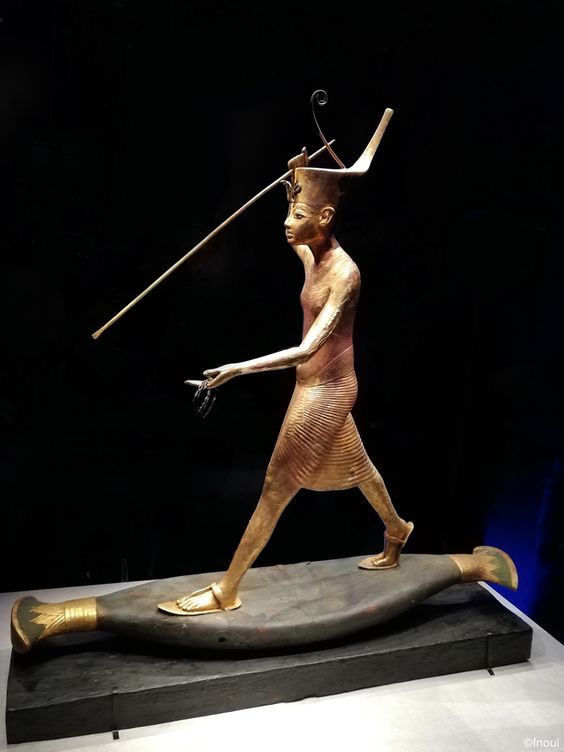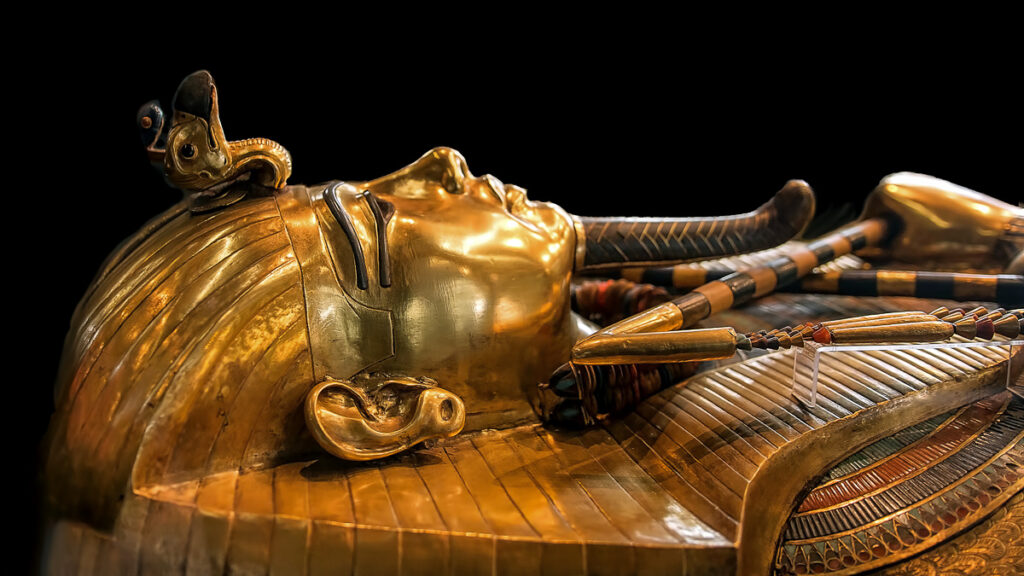
Unraveling the Mystery: The Curse of the Pharaohs
Introduction
Emerging from the narrow confines of the Siq, travelers are met by the iconic sight of Al-Khazneh, also known as “The Treasury,” standing proudly before them. This remarkable structure is meticulously hewn from the rose-hued sandstone cliff, showcasing intricate details in its design. Its grand facade ascends over 135 feet, reaching skyward along the vertical rock face. Massive Atlantes columns are adorned with elaborate carvings, featuring scrollwork, acanthus leaves, crowns, and figures.
These ornate elements grace the entablature and pediment, adding a touch of artistry to the imposing presence of Al-Khazneh. The craftsmanship and attention to detail displayed in this architectural marvel are a testament to the skill and creativity of the ancient Nabataeans who crafted it with precision and artistry over two millennia ago. Each carving and contour tells a story, inviting visitors to delve into the rich history and mysteries that lie within the heart of Petra.

Understanding the Curse of the Pharaohs
Also referred to as or the “Curse of Tutankhamun,” is a belief in the mystical forces that are believed to be unleashed upon individuals who disrupt the final resting places of Egyptian pharaohs, particularly within the tombs nestled in the Valley of the Kings.
This ancient belief holds that those who dare to intrude upon these hallowed grounds will face a series of calamities, including misfortune, illness, and even death. The notion of this curse has been woven into the tapestry of Egypt’s rich history, adding an air of mystery and caution to the exploration of these sacred archaeological sites. Despite its origins in ancient lore, the Curse of the Pharaohs continues to capture the imagination of modern-day enthusiasts, serving as a reminder of the enduring power of cultural beliefs and the enigmatic allure of Egypt’s ancient past.

Historical Origins
The roots of the Curse of the Pharaohs extend to the early 19th century, a time when Europe was in the throes of Egyptomania. As explorers and archaeologists unearthed the long-concealed treasures of Ancient Egypt, tales of misfortune and tragedy tied to these discoveries began to circulate. Nevertheless, it was the sensationalized narratives surrounding Lord Carnarvon and Howard Carter’s expedition in 1922, which unveiled the tomb of Tutankhamun, that firmly established the curse’s infamy.
This high-profile event amplified the mystique and captured the collective imagination, cementing the notion of an ancient curse associated with the uncovering of pharaohs’ tombs. The intersection of fascination, historical discovery, and lore surrounding this enigmatic phenomenon continues to enthrall and intrigue to this day, underscoring the enduring power of ancient mysteries on our modern sensibilities.

The Myths and Legends
The Curse of the Pharaohs, though enthralling, is met with a more pragmatic viewpoint in modern science. A significant portion of the reported fatalities and misfortunes can be ascribed to natural occurrences like infections, respiratory ailments, and accidents. The passings of figures like Lord Carnarvon and others linked to the Tutankhamun expedition find their explanations in medical science, effectively debunking the notion of a paranormal curse.
This rational analysis invites us to reevaluate the mystical aura surrounding ancient tombs and encourages a more empirical understanding of historical phenomena. It underscores the importance of approaching ancient legends with a critical lens, recognizing that while they may be steeped in mystery, there often exists a logical explanation rooted in the natural world. This shift in perspective opens up new avenues for comprehending the rich tapestry of history, reminding us that the past, though cloaked in intrigue, can often be illuminated by the light of reason.

Among the renowned inscriptions, one discovered on Tutankhamun’s tomb imparts a chilling admonition: “Do not open the coffin, for death shall slay with its wings whoever dares to disturb us.” This foreboding message has sparked extensive contemplation and captivation. It carries an air of solemnity, serving as a testament to the reverence and awe with which the ancient Egyptians regarded the sanctity of their burial grounds.
The inscription’s evocative language evokes images of a supernatural force poised to defend the eternal rest of the departed pharaoh. It beckons us to delve into the beliefs and rituals that permeated ancient Egyptian funerary practices, shedding light on the profound significance they attributed to the afterlife.
This enigmatic warning, etched into the stone of Tutankhamun’s tomb, transports us across millennia, inviting us to contemplate the mysteries that continue to envelop this ancient civilization. It stands as a poignant reminder of the enduring allure of Egypt’s past, beckoning us to uncover the layers of history concealed within its sacred tombs and monuments.

Scientific Perspectives
Though enthralling is met with a more pragmatic viewpoint in modern science. A significant portion of the reported fatalities and misfortunes can be ascribed to natural occurrences like infections, respiratory ailments, and accidents. The passing of figures like Lord Carnarvon and others linked to the Tutankhamun expedition find their explanations in medical science, effectively debunking the notion of a paranormal curse.
This rational analysis invites us to reevaluate the mystical aura surrounding ancient tombs and encourages a more empirical understanding of historical phenomena. It underscores the importance of approaching ancient legends with a critical lens, recognizing that while they may be steeped in mystery, there often exists a logical explanation rooted in the natural world. This shift in perspective opens up new avenues for comprehending the rich tapestry of history, reminding us that the past, though cloaked in intrigue, can often be illuminated by the light of reason.

However, it is essential to note that not all deaths can be easily explained. Some incidents remain shrouded in mystery, leading to ongoing debates and discussions within the archaeological community.
The Psychological Impact
Irrespective of the scientific elucidations, has left a deep psychological mark on individuals immersed in the realm of Egyptology. The magnetic pull of Ancient Egypt, coupled with the narratives of curses, has infused archaeology with an aura of enigma and peril. It stands as an emblem of the uncharted, a testament that in the era of scientific advancement, enigmas persist, evading complete comprehension.
The resonance of this age-old curse reminds us that there are still facets of history and ancient civilizations that remain beyond the grasp of empirical scrutiny. In the pursuit of unraveling the mysteries of the past, the shadow of the Pharaohs’ curse serves as a poignant reminder that the human quest for knowledge is boundless and that there are depths yet to be plumbed in the annals of history.
The Legacy of the Curse
Remains a tantalizing enigma, a testament to the enduring power of ancient legends. It continues to capture the imagination of both scholars and enthusiasts alike, adding an extra layer of intrigue to the study of Ancient Egypt. While science may provide rational explanations for many of the reported incidents, the allure of the curse endures, reminding us that there are still mysteries waiting to be unraveled.
History of The Curse of the Pharaohs
also known as the “Pharaoh’s Curse” or the “Curse of Tutankhamun,” is a belief in the supernatural powers that are said to be invoked upon those who disturb the resting places of Egyptian pharaohs, particularly their tombs located in the Valley of the Kings. This curse is said to bring misfortune, illness, and even death upon those who dare to trespass on these sacred grounds.
The origins of the Curse of the Pharaohs can be traced back to the early 19th century when Egyptomania gripped Europe. As explorers and archaeologists began uncovering the long-buried treasures of Ancient Egypt, stories of misfortune and tragedy surrounding these discoveries began to emerge. However, it was the sensationalized accounts of Lord Carnarvon and Howard Carter’s expedition in 1922, uncovering the tomb of Tutankhamun, that solidified the curse’s notoriety.
One of the most famous inscriptions, found on Tutankhamun’s tomb, reads: “Do not open the coffin, for death shall slay with its wings whoever dares to disturb us.” This ominous warning has been the subject of much speculation and fascination.
While modern science offers more rational explanations for the reported deaths and misfortunes associated with the curse, the belief in its supernatural power continues to capture the imagination of many. stands as a bridge between ancient mythology and modern science, weaving a narrative of mystery and danger that entices explorers and scholars to seek answers in the tombs of Egypt. Despite scientific explanations, the legacy of the curse endures, reminding us that there is still much to discover in the sands of time.
Conclusion
is a phenomenon that bridges the realms of ancient legend and modern scientific inquiry, weaving a narrative of intrigue and potential peril. It beckons both intrepid explorers and scholarly minds to probe the depths of Egypt’s ancient tombs, seeking to unlock the mysteries held within. While scientific scrutiny has dispelled some of the more fantastical aspects of this age-old curse, its indelible mark endures, serving as a poignant reminder that within the sands of time lie countless enigmas yet to be unraveled.
This enduring fascination ensures that the Curse of the Pharaohs will continue to be a topic of discussion and intrigue for generations to come. The enigmatic aura that surrounds the tombs of Egyptian pharaohs is woven into the very fabric of human curiosity and exploration. It remains a testament to the power of ancient myths and their ability to capture the imagination, even in the face of empirical investigation and scientific progress.
The curse’s roots lie deep in the annals of history, originating in a time when Egyptomania swept across Europe in the early 19th century. As explorers and archaeologists unearthed the treasures of Ancient Egypt, stories of misfortune and tragedy began to surface, linked to these remarkable discoveries. However, it was the widely publicized account of Lord Carnarvon and Howard Carter’s expedition in 1922 – which unveiled the tomb of Tutankhamun – that firmly entrenched the curse’s notoriety. This high-profile event amplified the mystique, captivating the collective imagination and solidifying the notion of an ancient curse associated with the exploration of pharaohs’ tombs.
Despite the rational explanations provided by modern science, the Curse of the Pharaohs continues to exert a profound psychological impact on individuals involved in the field of Egyptology. The allure of Ancient Egypt, coupled with the enduring tales of curses, imparts an air of mystique and danger to the discipline of archaeology. It stands as a symbol of the unknown, a reminder that even in an age of scientific enlightenment, there remain mysteries that elude our complete understanding.
Inscriptions on the tombs, like the one found in Tutankhamun’s resting place, further contribute to the aura of mystery. The ominous warning, “Do not open the coffin, for death shall slay with its wings whoever dares to disturb us,” adds an element of solemnity and invokes images of a supernatural force poised to defend the eternal rest of the departed pharaoh. This evocative message transports us across millennia, inviting contemplation of the beliefs and rituals that underpin ancient Egyptian funerary practices. It underscores the profound significance attributed to the afterlife and the lengths to which they went to safeguard the sanctity of their departed rulers.
The Curse of the Pharaohs serves as a captivating link between ancient folklore and contemporary scientific inquiry. It tells a story of intrigue and potential peril, drawing in both adventurers and scholars to delve into Egypt’s tombs in search of answers. While science has unraveled certain mystical elements, the imprint of the curse persists, serving as a poignant reminder that the sands of time hold untold secrets.
Ultimately, it is this enduring allure that assures the curse will remain a subject of conversation and fascination for generations yet to come. The enigma surrounding the tombs of Egyptian pharaohs is etched deep into the fabric of human curiosity and exploration, ensuring that this captivating narrative will continue to captivate minds for years to come.





Comment (0)